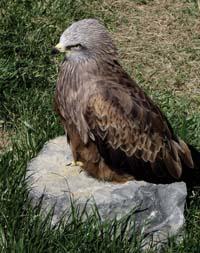Saia eta ardia: an uncomfortable tale for everyone

At that time, many Spanish biologists expert in essay denied that vultures attacked live cattle and did not want to investigate the issue. However, from 1998 the veterinarians began to perform autopsies to the cattle to determine, in case of denunciation, if the animal consumed by the vultures was dead or alive (or sick). These techniques continued to apply in the coming years.
More denunciations More denunciations
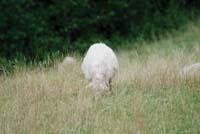
Over time, the number of complaints increased. In Navarre, from 32 complaints in 1996 to 101 in 1998. In the following years it decreased to a minimum: In 2002, 2003 and 2004, 16, 15 and 19 cases were recorded respectively. However, since then the number of complaints has increased again and the number of cases reported in 2007 has increased considerably. By September there were more than 100 complaints.
And Navarre is no exception. In Catalonia, for example, fewer than five complaints have been made until 2006, and by September 2007 there were more than 40. And in Iparralde equal. Its experts considered the case of Luzaide as an abuse, since there was no complaint in the nearby lands of the North. They only had five annual complaints until 2000, but thereafter the number increased: 39 cases in 2006 and more than 90 cases for September 2007.
The evolution has been the same in all territories. However, this is an evolution of the cases reported; it is important to know how many of these cases can be attributed to the conduct of the law firm. This is the work of veterinarians. In some cases, the animal has died before the arrival of the thugs; in others, they are dying animals, weakened or seriously injured; and in others, it is simply a fraud of the breeders. Veterinarians did not find cases of aggression against fully healthy cattle. On the other hand, it must be said that in many cases it is impossible to determine the status of the animal before the arrival of the vultures.

Crazy cows
The proliferation of complaints is due to several factors. The attacks that have occurred have to do, among other things, with the disease of mad cows. Since the detection, drastic measures were taken for the management of dead cattle. From the point of view of the vulture problem, this measure has had two consequences, on the one hand, the systematic collection of dead cattle from the mountains and, on the other, the closure of the slaughterhouses.

The abandonment of the dead cattle in the countryside has long been illegal in Spain. However, before the onset of mad cow disease, it was not controlled or sanctioned. The situation changed, it has wanted to control. Since the fall of 2006, the law has been applied very strictly. Whenever possible, the rancher is forced to collect the livestock sacrificed. In some cases it is impossible, especially when cattle are away from the road. Only in these cases do they remain without collecting the corpses. This occurs in the summer months, but in winter there are hardly any cattle killed on the mountain.
In France a similar problem arose, but the authorities have not opted for the collection of all the corpses. The Ministry, in a 1998 decree, recognized that vultures are cleaners and since 2003 have made an effort: they analyze 4% of the sheep and goats that leave the vultures to eat and all the cows to ensure that they do not have diseases. Martine Razin, the head of the monitoring of French body birds, says vultures save a lot of money associated with the transport of corpses. And yet, the activity is very expensive. According to Razin data, the trucks cover 26,000 kilometers a day.
The closure of vulture grasslands has affected both sides of the limit. In fact, the experts of Iparralde believe that the closure of the grasslands in Aragon is what has most influenced them. The grasslands have almost disappeared in Aragon, they were about 200 and practically none. And in this period, the number of complaints of attacks of northern vultures has increased considerably. In this territory, the grasslands have not disappeared, which currently have a network of 46 small grasslands in operation.

In Navarre the first grasslands of the whole state were opened and it is true that since then the vulture population has grown. But Campion questions that one is a consequence of another. In those years, the cases of poisoned and triggered vultures were also significantly reduced. Therefore, many factors participated in the proliferation of the firm and there is no exhaustive investigation of its causes. Therefore, it is very difficult to determine how grasslands affect both vulture populations and interactions with livestock.
Saiak gose?
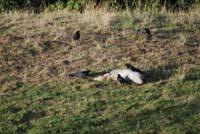
Again, food areas have been opened in several communities. It is a very general conviction that the situation of vultures indicates that they are hunger. But that is also questioned by experts. "The relationship between attacks and hunger is very simple. But, at least in Navarre, reports of aggressions began before hunger. (...) The link is less correct. There are many factors that intervene and we are not very clear how," says Campión.
The only way for biologists to measure hunger is to calculate the availability of food. This means calculating how many animals there are in each place and time, how many of them die and how many kilos each dead. And, of course, we must take into account the number of corpses collected.
From all these variables it is deduced that vultures have always had to eat. More than they eat. It is observed, for example, in the data of Navarre. In 1986, vultures ate less than 25% of available food. Over time this number has increased. In 2004 it was approximately 60%, and today it still has more food than the saí needs. Therefore, hunger does not explain that the number of complaints of attacks is high.
An alimoche needs a daily average of 400 grams of meat. This amount varies throughout the year; when the offspring are in the nest, from March to August, it needs more than other months: 700 grams daily approximately. However, the denunciations of aggressions are not more numerous in this period from March to August, being more numerous between April and May. It is at this time when cattle give birth. According to this data, most aggressions do not occur when vultures need more, but when sheep, goats, etc. They are more vulnerable. From this point of view, the hunger factor cannot be ruled out, but does not correspond to the number of complaints.
 (Photo: R. R. Imaz)Too much vulture?
(Photo: R. R. Imaz)Too much vulture?

The same applies to the alleged overpopulation of vultures. It is difficult to say what is the superpopulation in this case. The sizes of the populations are well known given in breeding pairs. According to data from 2006, in the North there are about 580 couples and in the Spanish Pyrenees about 5.000 couples. Navarra 2.371, Huescan 2.188 and Lleida 388 pairs. The data of the Autonomous Community of the Basque Country are lower. In Gipuzkoa, for example, in 2006 there were 55 couples. In general, the population is not small, but to say that there is overpopulation is something else.
And although the superpopulation is admitted, the data do not clearly indicate that the reason for the complaints is the excess of alimoche. Most of the complaints are concentrated in places with a lower density of vultures. This effect is visible in all territories. In Catalonia it draws attention. Antoni Margalida, vice president of the Catalan group for the protection of the bearers, has compiled data related to the law firm: most of the complaints have been made in the region of Osona and there is a big difference with the rest of regions. But in Osona, the sai does not nidify.
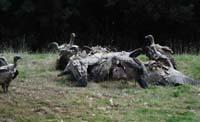
This latest data suggests that the claims of farmers are a fraud, but experts do not believe that this is true. "In most of the complaints, the rancher finds the dead and eaten cattle and does not know what has happened," says Margalida.
Includes a related example. A shepherd saw the vultures attacking an entire flock of sheep. The sheep, frightened, escaped breaking a barrier. The situation was very chaotic and they began to eat a sheep that the vulture did not escape. But the study of the deceased sheep confirmed that it was dead beforehand and that the bustle arose when the sai descended to eat. The flock did not allow the shepherd to see his deceased, so his conclusion was that the vultures attacked the sheep with life.
But it is not always so. In many cases it is not possible to confirm the current situation of the attack. "The denunciations are always based on the version that the pastor counts," explains Margalida. The Gipuzkoan pastor Jesús Etxezarreta relates the attack of the vultures who denounced: "A sheep was lying in a place and I thought the child would be doing. Then I went and saw (sae) that I had punctured below. They took him the guts and so it was finished. He tried to raise the sheep, but when he began to rise, the vultures attacked him and ate him alive."

Small problem Small problem
Experts recognize that the current situation is causing a quantitative change in the behavior of vultures, that is, an increase in interactions between vultures and cattle. But from there to become an active predator there is a lot of margin. As poison and shooting die much less vultures than before, they are increasingly faithful to the human being. They are increasingly less afraid. This has happened with other species. However, they question whether this is a big problem. In Navarre, 5,000 euros were paid in the year of greatest compensation. They say that if the vulture attack is paid for that small amount of money, it is not a real economic or social problem. It is a conservation problem.
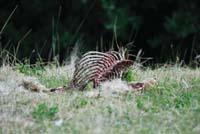
But they have given him a great space in the media, with a great tone of sensationalism. Hitchkock Birds have equated to the film and, once released, the vultures attacked a mountaineer. According to experts, these excesses cause great damage, due to their great influence on public opinion.
Biologists and farmers must manage the problem of the firm, with the help of the authorities, because there are two teams involved. On the one hand, the lack of scientific information about vultures, the need for a demographic model of colonies, the investigation of the whole of the peninsular population, the understanding of the mortality of vultures (mortality by wind farms and many other factors), etc. On the other hand, it is necessary to develop a suitable model of livestock, including the management of the pens, among other things because the tufts are very dependent on extensive livestock.
In addition, biologists ask that all the advantages of the presence of vultures be taken into account. They eat the bodies of the animals, carry out a great cleaning work and avoid the spread of diseases. In addition, there are cases that have fostered ecotourism. People come to see the vultures in many places. "Vultures bring benefits," explains Doñana biologist José Antonio Donazar. "When calculating the cost of conservation of a species, we must also take this data into account."
The vulture is not in danger of extinction. In recent years the human being has not been considered as a beast, which allowed the expansion of the population of vultures. However, experts now fear that reports of attacks change. In cases where the complaints have not been fraudulent, it has been shown that the animals were in danger of death, very weak or sick, so the aggression is questioned. But it is very difficult to broaden this idea.
